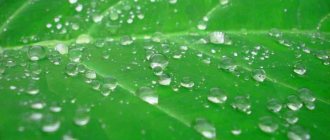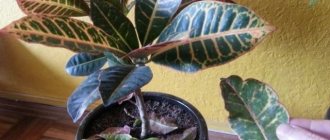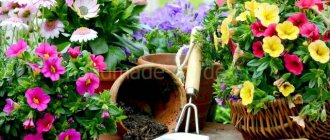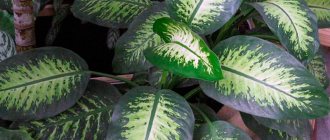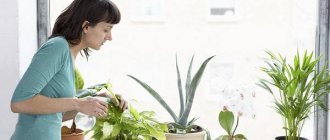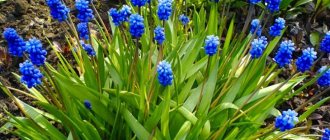Spraying is an important procedure for caring for many types of indoor plants. In order for moistening the stems and leaves to bring maximum benefit, you need to know how, with what and at what time it is best to produce it. The frequency of spraying may depend on the air temperature, season of the year and stage of flower development. It is undesirable to moisten the leaves of some plants due to the peculiarities of their structure; water getting on the inflorescences can lead to a deterioration in their appearance and rapid falling.
Why do you need to water flowers at home?
First, you need to understand why watering indoor plants is necessary. Plants need water for various reasons. Firstly, it is the main component of tissues: some plants, primarily herbaceous ones with soft stems, consist of up to 90% water.
Water also has a nutritional function. The mineral salts contained in the soil are dissolved in it, and it carries them from the roots to the leaves of plants. Finally, water plays an important role in the respiration process: it evaporates through the stomata located on the underside of the leaves and humidifies the air surrounding the plant.
What happens if you don’t regularly water your indoor flowers? If a houseplant is not watered enough, then, as practice shows, the leaves and flowers become flabby and drooping, and the stems of herbaceous species fall off. Then the leaves wither and fall off.
In cacti and succulent plants, which usually contain a lot of water, with a lack of moisture, you can observe a clearly noticeable wrinkling of the entire plant.
But before, with the above-mentioned symptoms, you immediately grab a jug of water and water your indoor plants as much as possible, with all your heart, you need to think about the fact that excessive watering of house flowers, leading to excess moisture, is also harmful to crops, and the same symptoms appear the same as with a lack of moisture.
Why this happens can be explained simply: with excessive watering and spraying of indoor plants, all the pores in the soil that previously contained air are filled with water. In such a case, botanists talk about “stagnant waterlogging of the soil.” In such soil, which does not contain air, the root system can no longer function normally and absorb water. When houseplants are overwatered, the supply to the upper part of the plant stops, it dries out, while the lower part “sinks.”
You can find out how sensitively plants react to waterlogging and drying out of the soil from the recommendations for caring for individual species.
The next section of the article is devoted to how often you need to water indoor flowers, and by what factors you can distribute the level of water consumption.
Complex fertilizing
But it’s even easier to feed plants leaf by leaf with modern complex fertilizers. The fact is that in addition to the main nutrients - nitrogen, potassium and phosphorus, plants need microelements - zinc, boron, iron, molybdenum, copper, calcium and others.
Superphosphate, potassium sulfide and urea do not contain them, but they are present in modern fast-acting water-soluble fertilizers that work well both with root and foliar feeding. They contain all the necessary elements, and in a form easily digestible by plants. And the instructions contain instructions on how to prepare a solution for each type of fertilizing.
Even if the fertilizer is intended exclusively for application at the root, it can still be used for leaf treatment if the solution is made weaker. For example, if for root feeding you need to dissolve one measure in 7 liters of water, then to spray plants with the same volume of water, three times less fertilizer will be required.
To be sure, you need to prepare a small amount of the solution and test its effect in the evening on some inconspicuous area. If there are no burns on the leaves in the morning, then the concentration is acceptable. In any case, it is better to make an insufficiently strong solution than to harm the plants.
***
Unfortunately, you will not be able to provide plants with nutrients in the required quantities only by foliar feeding. The need of plants for macro- and microelements is so high that it is impossible to satisfy it only through leaves: it will not be possible to increase the concentration in the fertilizer solution without harming the plants, and it is unlikely that it will be possible to spray them on the leaves every day. Foliar feeding does not replace the application of fertilizers to the soil, but only qualitatively supplements it.
And yet, foliar feeding is necessary and useful. I'll wait until evening and spray my apple tree with rolled leaves with potassium fertilizer. I wish everyone a good mood and success in gardening.
How often should you water indoor flowers: factors for water consumption by house plants
Precisely because there are no uniform recipes for properly watering home flowers, you should familiarize yourself with some basic rules, which are discussed below. They will help develop the sense of proportion necessary for watering.
How often you need to fertilize and when to replant crops can be determined exactly. But the frequency of watering depends on so many reasons that you will only find approximate information in books. You will learn whether the plant should be watered a lot or a little.
How often you need to water your indoor plants is determined by the following factors.
- Pot material. The same plant in a clay pot requires more water than in a plastic pot, as water evaporates through the porous clay walls.
- Pot size. A plant in a large pot needs more water than a plant in a small one.
- Location. On a southern window, plants most often require more water than on less lit eastern, western, and even more so northern ones.
- Temperature. Plants require more water in a warm room than in a cool room.
- Weather. On a hot summer day, the plant needs more water than on a cool and rainy day. In the heat, plant leaves evaporate more water, which means you need to water indoor flowers more often during this period, as experienced plant growers advise.
- Season. During the growing season (for most species, spring and summer), when plants form leaves and flowers, they require more water than during the dormant period (usually winter), when growth stops.
Next, you will learn about when to water indoor plants depending on soil moisture.
General characteristics and classification
Fungicides contain a different set of active substances. Therefore they are divided into two groups:
- biological;
- chemical.
Biological drugs (contact) are often used to prevent the disease. In some cases, they help eliminate the problem at an early stage of the infection. The substances contain spores of beneficial microorganisms. They are artificially released onto a culture or substrate, where they actively reproduce. As a result, pathogenic fungi simply die.
It is necessary to treat the plant with contact fungicides 3-5 times every 15 days.
Chemical fungicides (systemic) consist of components that penetrate inside the shoots and leaf blades. In addition, they are an excellent disinfectant for soil and seed. As a rule, systemic fungicides for indoor plants are diluted with clean water. And then, the crop is generously sprayed. Active substances disrupt the functioning of biochemical systems inside shoots and foliage. After a short time, pathogenic fungi die.
The destruction mechanism consists of a number of processes:
- respiratory failure of pathogenic microorganisms;
- stopping the division of fungal spores;
- creation of inhibitory substances;
- inhibition of energy metabolism;
- release of toxins.
All antifungal preparations for flowers are sold as powder, emulsion or tablets. Before use, it is advisable to read the instructions. Typically, fungicides are diluted with water and then poured into a spray bottle. Treatment is carried out according to the degree of the disease.
The interval between procedures is at least 10 days. Substances are also used to strengthen the immunity of weakened domestic crops.
When to water indoor flowers: time to water house plants
To correctly determine the time to water indoor flowers, you need to check the soil moisture. There are all sorts of ways to do this:
- The simplest method is to press your thumb into the ground about 1 cm from the surface. If your finger still feels moisture, then you can wait until watering.
- Pro Method (Clay Pots Only): Hold the pot in your hand and tap the side of the pot. If the clay rings, you need to water it. If the sound is muffled, it means there is still enough moisture in the ground.
- Technical method: Specially designed moisture meters are immersed in the ground. They will indicate when the soil is too dry.
Important! There are plants for which generally accepted laws regarding when to water indoor flowers do not apply. Such as Cyperus love constant dampness, and cacti can go without a drop of water for weeks. Along with the basic rules, we must not forget about the individual needs of plants.
If you are not yet sure about the right amount of water and frequency of watering, then you should start with plants that can easily tolerate excess moisture.
Below we describe how to properly water indoor flowers in winter.
Vitamins needed for healthy growth and flowering
Indoor flowers are the pride of any housewife. She rejoices at how they grow and bloom. In order for the plant to remain healthy and attractive for a long time, it needs vitamins.
IN 1
The vitamin helps the plant survive stress; if it is deficient, the growth of the plant slows down, the leaves lose their color and healthy appearance. Flowers are fed with a solution in the proportion: 1 ml per liter of water. B1 decomposes when exposed to sunlight, so it is better to spray it in the evening. The excess does not accumulate, so there is no fear of overdose.
AT 2
Performs the function of strengthening the plant’s immune system, giving strength to resist various bacteria.
AT 3
Recommended for use together with B1 and B6, in the same proportion. Nicotinic acid (vitamin B3) is the only vitamin involved in hormonal metabolism. Thanks to this property, it can rejuvenate the plant, stimulate flowering and the appearance of new shoots. The vitamin is resistant to temperature changes and ultraviolet radiation.
AT 6
An indispensable vitamin for boosting immunity, it is recommended to be used when it is necessary to “exit” wilted and sick representatives of the home flora.
AT 12
The vitamin takes an active part in the production of chlorophyll and charges the plant with energy. The composition contains cobalt, which allows plants to be well saturated with oxygen. Relevant in winter, when there is not enough sunlight and the room is rarely ventilated.
WITH
Ascorbic acid protects the plant from chlorosis and increases growth.
All vitamins are diluted in the proportion of 1 ml per liter of water.
Rules for watering indoor plants in winter
It is very important that you change your watering schedule around the end of September. At this time, most plants begin a dormant period when growth almost completely stops. Plants absorb less moisture from the soil. To avoid stagnant waterlogging, water much less frequently.
It is best to remember the three main rules for watering indoor plants in winter:
- Rule one. The colder the plant is in winter, the less it needs to be watered.
- Rule two. Watering at home those flowers that needed water daily in summer should be done once every three days in winter.
- Rule three. This is not the case with winter-blooming species such as azaleas (Rhododendron). Such plants require slightly more water throughout the flowering period.
The next section of the article is devoted to the best way to water indoor flowers so that they grow better and delight you with lush flowering in due time.
Causes of aphids
The parasite can get on home flowers in various ways:
- A winged female flew through an open window in the room.
- Delivered by a pet or a person on clothing. The larvae stick very well to people's clothing and animal fur.
- I was on a recently acquired plant, from which I quickly moved to others.
- Larvae were present in the mixture used for planting.
- They brought it along with flowers that stood outside, on the balcony or loggia in warm weather.
- They brought in ants that feed on the excess juice produced by this pest.
The best way to water indoor flowers: what water to use for watering house plants
In those days, when rainwater was ideal for watering indoor plants, this topic could be quickly closed. Today everything looks different. In most areas, what falls from the sky is more likely to harm indoor plants than to benefit them - rain contains so many harmful substances. So what kind of water should you water your indoor flowers so as not to harm your “green pets”?
If you still want to use rainwater, you should start collecting it half an hour or even an hour after the rain starts. Then it will contain less unnecessary impurities of foreign substances.
In terms of harmful compounds, tap water for watering indoor flowers is considered less problematic, but it also has one major drawback: it contains lime, and most plants cannot tolerate excess calcium. Water hardness is given in German degrees of hardness (°dH). In this case, 10dH means that 1 liter of water contains 1 mg of lime. You can find out the hardness of your tap water at a waterworks or have a water sample analyzed in a laboratory.
Water hardness up to 9 °dH does not cause problems for most indoor plants. Hardness between 9° and 12°dH can be reduced by settling or boiling the water. Water hardness above 12 °dH is undesirable for all plants.
If you know what kind of water to water your indoor plants, but the tap water in your home is too hard, you should definitely soften it, because not a single plant can tolerate high concentrations of lime. To do this, the following measures should be taken:
- When the hardness is between 10° and 12 0dH, it is enough to boil the water; in this case, lime is deposited in the form of plaque on the walls of the container.
- In stores you can buy jugs with ion exchange filters that soften water. Filters should be changed periodically.
- Liquid or powder water softeners are suitable for softening large volumes of water.
Knowing the best way to water your home flowers, you can extend the life of your home crops. And you can do without the old method of softening water using a bag of peat, so as not to reduce the already small reserves.
Below we describe how to properly water indoor plants in various ways.
Don't forget about safety
For indoor plants, they do not use chemicals that require special protective clothing. But this does not mean that safety measures do not need to be observed. Before you start processing plants, you should put on gloves and change into work clothes that you can immediately put in the wash (considering that some preparations can leave irreversible marks on textiles).
Respiratory protection is a measure that is rarely used in rooms. But since most insecticides and fungicides are sprayed with fairly fine sprays, it is not a good idea to inhale microparticles of the drugs during application at close range. A simple protective mask perfectly filters the air and minimizes contact with drugs.
If the working solution of fertilizers or other products gets on the skin, it should be washed off immediately with plain soap. In case of contact with eyes, rinse as quickly as possible. At the slightest sign of irritation or suspicious reactions, you should consult a specialist.
Household members also need to be protected. Fertilizers, acaricides, insecticides, fungicides are not substances to which children and pets should be allowed. This applies to both the processing itself and the time it takes for the leaves to dry.
Before handling plants, you should wear gloves.
How to water house plants: methods of watering indoor flowers
Regular watering in small doses does not bring anything good to plants. In this case, water penetrates only into the top layer of the earth. The main part of the roots that absorb water is located in the lower third of the pot.
You need to water thoroughly. Most plants should be watered thoroughly - until the water comes out of the bottom hole - after about half an hour, drain the water from the pan again so that the plant does not get its feet wet.
It is important to monitor the water temperature. Ice water can shock most plants so much that the leaves wilt.
Ideal water is at room temperature, which corresponds to the temperature of the soil in the flower pot. Reaching this temperature is not a big problem: you just need to fill the jug in the evening for watering the next day. Overnight the water temperature will become equal to room temperature. A pleasant side effect: excess chlorine from the water will evaporate.
Watering time is also an important condition for normal plant growth. Water in the morning if possible. If you water in the evening, the soil and leaves will remain damp for a long time, which often causes fungal diseases.
There are two ways to water indoor flowers: from above or from below. Both methods have their advantages and disadvantages:
- Watering from below. If the leaves of a plant such as Saintpaulia ionantha cannot be wetted, if the plant does not like cold water, or if it grows outside the pot like Soleirolia soleirolii, then it is preferable to pour water into the tray of the pot. Together with water, fertilizer salts also rise to the top layer of soil, where they accumulate. Often a white coating appears on the surface of the earth after this. In such cases, you should periodically use the method of watering indoor plants from above or remove the top layer of soil substrate.
- Watering from above. With regular watering from above, directly onto the surface of the substrate, the soil is better saturated with moisture, and nutrients are distributed optimally. But at the same time, the water should be evenly distributed over the surface, otherwise depressions will quickly form through which the water flows without saturating the entire lump.
If there is a high lime content in tap water, it is better to water from above. In this case, lime binds in the upper layers and does not reach the roots of the plant at all.
Rules for spraying indoor flowers at home
A type of additional provision of moisture to plants is spraying indoor plants with sprayed water. Spraying does not compensate for the lack of watering, and additional watering does not replace spraying.
Water is sprayed onto plants in order to increase humidity in the immediate vicinity of the leaves and thereby reduce evaporation. It is especially necessary to spray home flowers on hot summer days, as well as in winter in apartments with central heating.
For spraying indoor flowers, the same rules apply as for watering:
- Avoid irrigating plants in the midday heat; drops of water on the leaves turn into magnifying glasses and cause burns.
- When spraying house plants, do not spray ice water.
- If possible, use soft water with a low lime content, otherwise unsightly lime spots will appear on the leaves.
The flowers of some plants, such as azalea (Rhododendron) or pavonia, should not be wetted because they become unsightly.
Other plants with sensitive leaves, such as hybrid Saintpaulias (Sainpaulia ionantha), should not be sprayed at all.
Next, you will learn how to water indoor flowers that are too sensitive to lime.
Chemicals are no substitute for care and cleanliness
The promise of quick results when using any insecticides and fungicides is reassuring to anyone, but they cannot replace care and purely “mechanical” treatment. Diseased plants require not only timely treatment with special means, but also basic preventative and care measures:
- removing insects from the plant manually;
- wiping leaves and shoots from dust and dirt;
- removing dry or damaged leaves and dirt from the soil surface;
- cleaning contaminants in trays and pots;
- souling;
- spraying, increasing humidity or, conversely, decreasing it.
Dust and dirt are the main enemies of plant health. Using only sanitary measures it is not always possible to solve a problem, for example, with spider mites or scale insects, but hand washing and care is the first step to victory and the best assistant of “chemistry”.
Dust and dirt are the main enemies of plant health
How to water flowers sensitive to lime at home
If you have flowers that are sensitive to lime, they require special watering.
Azalea (Rhododendron simsii) . During flowering, bathe once every 2 weeks; do not spray flowers; put in a cool place; feed lightly; grow in non-carbonate soil.
Brunfelsia (Brunfelsia pauciflora) . Purple flowers bloom in late winter; cannot stand the sun; do not forget about the drainage layer; Do not spray the flowers - they become spotty.
Anthurium. It does not tolerate lime at all and is sensitive to increased concentrations of salts in the soil; take softened, heated water; feed lightly; do not spray the flowers.
Gardenia (Gardenia jasminoides). Wonderful, fragrant flowers; but a very sensitive plant; It blooms better if it is in a cooler place during the budding period; spray frequently, but not the flowers.
Camellia (Camellia) . Flowers range from white and pink to bright red, plain or interspersed; avoid temperature changes; in summer he likes to stand outside; Spray daily in winter.
Aglaonema. Similar to Dieffenbachia, but requires more care; does not tolerate direct sun; likes to always stay warm; needs high air humidity; plant in wide, low pots.
Calathea. A beautiful single plant with a distinctive leaf pattern; should be warm all year round; high air humidity and high soil temperature; loose soil; good drainage of the pot.
Usambara violet (Saintpaulia). Endless variety of colors, including two-tone, smooth or curly leaf edges, beautiful mini plants; do not spray leaves; Water only from below.
Araucaria (Agaicapa). Requires a lot of space to spread branches; do not place in bright sun; keep in a cooler place in winter; spray frequently; feed only lightly.
Bromeliads (Bromeliaceae) . These are attractive exotic plants that arrived in our apartments from Brazil.
All plants of this species, such as:
Aechmea
Neoregelia
Nidularium
They have some features that you should consider, and they will help you when caring for these plants.
Bromeliads form with their long pointed leaves, which are arranged in a circle, something like a funnel or rosette. It should be filled with water, depending on the type, all year or only during the growth period. It is recommended to update the water in the funnel approximately every two weeks.
Which plants should not be sprayed?
Succulents can easily withstand dry air thanks to the moisture reserves in their thick stems and spines, which shield the genus from overheating from the bright rays of the sun.
Some species not only do not need spraying, but can also be damaged if drops of water get on the stems and leaves. These include plants that naturally grow in countries with arid climates, as well as those with thin and tender leaves, with a jagged edge along the edge or having a fleecy or wrinkled surface.
Flowers that do not require spraying include:
- geranium, caladium, begonia, pelargonium (leaves are thin and tender);
- saintpaulia, gloxinia, gray peperomia (pubescent foliage);
- streptocarpus, coleus, calceolaria (wrinkled leaves);
- cacti, aloe, crassula and many other types of succulents with thickened stems and leaves.
When spraying any plants during the flowering period, avoid getting water on the flowers. When wet, the petals stick together and soon wither.
In fruit-bearing species, moisture washes away pollen, which reduces the likelihood of flower pollination. Densely pubescent or wrinkled leaf surfaces slow down water absorption and evaporation. At low air temperatures, they can begin to rot; when exposed to sunlight, a burn appears in the place where moisture accumulates.
Streptocarpus and other flowers with wrinkled leaf surfaces are not sprayed.
However, all these plants need to increase air humidity and remove dust from the leaves. To do this, just place a container of water or a room humidifier near the bushes. You can clean the leaves with a soft brush or by taking a warm shower once a month.
The procedure is carried out in the evening, moving the flower pot to a shaded place and returning it to the window after it has completely dried. Before spraying, the soil under the cacti is allowed to dry thoroughly or the soil is covered with film. When using a sprayer with very small holes, the amount of water flowing down the stem is significantly reduced.
Over- or under-watering indoor plants
It often happens every now and then that the plant receives too little or too much water. Before watering your houseplants, learn about what happens when you overwater or underwater.
Insufficient watering. If a plant's leaves or flowers fall off, the edges of the leaf blades become brown, and the leaves themselves look dull, then all these symptoms are signs of a lack of water. Rare watering of home flowers usually occurs during the owners' vacation. If you returned quickly and managed to react in time, then the plant can still be saved. A plant can dry out even when it is watered regularly, but never enough. In this case, the earthen lump dries out, a void appears between it and the walls of the pot, through which water flows down without even wetting the soil.
What to do? First, carefully loosen the top layer with a fork and press the soil with your hands to the edges of the pot. Then bathe: immerse the pot to the brim in a bucket of water and keep it there until air bubbles stop rising. At the same time, spray the above-ground part of the plant with water mist. After this, the plant is placed in a cool place. After half an hour, empty the pan of water!
Excessive watering. The first sign of excess water is the moss that covers the ground.
What to do? In such cases, it is often enough not to water the plant for several days and dry it slightly.
What to do in serious situations? It becomes difficult when spots appear on the leaves, the ground is thoroughly wet and smells sour - the roots are already rotting. In this case, you can try the following treatment:
- Spread a lot of newspapers in a shady place in the apartment;
- Remove the plant from the pot and place it on newspapers to dry;
- Only a few days later, after the soil has dried out somewhat, transplant it into the pot again;
- If at the same time you find brown tips of the roots, they should be cut off.
For indoor plants, you can buy very beautiful second pots made of ceramic or plastic everywhere, variegated and monochromatic, sometimes with attractive patterns. They often enhance the impression of flowers. But more than one lover of second potties has caused a lot of harm to their pets.
Second pots, no matter what, have one big drawback: water often accumulates in them unnoticed. As a result, up to half of the inner pot is in water, which causes stagnant waterlogging, which is unacceptable for the plant, because the roots rot, and soon the flower can be thrown away.
Check for water between the pots some time after watering. Place a layer of pebbles at the bottom of the outer vessel, on which you place the pot.
Description of aphids
Aphids are small insects with an elongated body and long legs. Its belly is quite wide with a pointed end. The color varies: pale, greenish, pinkish, pale yellow, black. The most common aphid is white. All types cause the same harm. The insect sucks the sap of plants by piercing the leaves. Feels great in any environment and adapts well. Reproductive function is well developed.
Species differ in color and the presence of wings. The winged one searches for and captures new habitats, and the wingless one reproduces. Each female lays about 100 larvae, which after 2 weeks become adults. Most often they can be found on young shoots and buds, and on the leaves - on the inside.
Indoor plants that love abundant spraying and watering
Now check out how to water flowers at home that love plenty of moisture.
Reed (Sdrpus cernuus). Light green ornamental grass; white flowers the size of a pinhead; no special requirements regarding location; there should always be water in the pan; spray frequently.
Hydrangea (Hydrangea) . Due to the large, soft leaves, the plant consumes a lot of water, especially in summer; use only softened water at room temperature; During the dormant period, water less.
Decorative asparagus, asparagus (Asparagus) . A well-known green element in bouquets; requires constantly moist roots in summer; In winter, water less, especially if the plant is in a cool place.
Indoor bamboo, pogonatherum . Refers to very thirsty plants; If leaves curl, water immediately; on hot days, spray frequently; There is always water in the pan.
Indoor calla lily (Zantedeschia). Comes from the swampy areas of Africa; during the period of growth and flowering, it requires a lot of water; from June to early August, water less; Requires a lot of light for flower development.
Syt (Cyperus) . Looks beautiful in aquariums too; like a marsh plant must always have its roots in the water; It tolerates heat in winter, but needs frequent spraying.
Watering indoor plants in the absence of owners: how to water house flowers during vacation
If you need to leave and there is no neighbor who could occasionally water the flowers, then you need to ensure that the plants are self-maintaining. This is possible, at least for some time.
Watering indoor plants in the absence of owners can be done using homemade water supply systems. The following methods have proven themselves well and do not require large expenses:
- Thick Strings: Arrange pots of flowers around a bucket or large pan of water. Take long lamp wicks or cotton threads and stick one end into the soil of the pots. The second end is lowered into the bucket. If the threads are pre-wetted, the flow of water will improve.
- A greenhouse made from a bag for plants that need high air humidity. A greenhouse from a bag will serve as an excellent option for moistening flowers during the holidays.
In specialized stores you can find a number of different systems for watering home flowers during the holidays. In any case, you should first check how long the water supply lasts.
A wet canvas is used to provide water to a large number of plants. The canvas can be placed on a surface next to the kitchen sink tank with one end of it in the water. Plants placed on a damp canvas can absorb moisture from it. The pots for this must be clay.
A clay cone for watering indoor flowers during the holidays can be recommended for single pots. It is filled with water and connected with a hose to the tank.
Plants that are left alone should be moved into the shade. Before leaving, you need to remove not only all withered and faded buds, but also all unopened buds.
If you want to save yourself from such problems with watering as too much or too little, today or tomorrow, you can transplant all your plants into pots with automatic water supply. They are containers with a double bottom where a reservoir of water is located. Through a wick or similar device, the plant itself takes in exactly as much water as it needs. Naturally, such a device only works as long as you remember to replenish your water supply. This must be done every 14 days. But for the period of a short vacation, your plant is provided with water.
The last section of the article is devoted to how to wash indoor plants.
The processing area must be isolated
Finding a closed, empty room to spray with insecticides or fungicides is almost impossible. But it’s also not worth carrying out the treatment “just anywhere,” right on the windowsill or on the nearest table. Plants must be sprayed with insecticides and fungicides separately. Away from valuable pieces of furniture and decor, recreational areas, living rooms - on a special work table or chair protected with film, in the open air or in a well-ventilated place (on the balcony, in the corridor, in utility rooms, etc.). It is convenient to spray plants in the bathroom, where you can immediately wash the walls and surfaces.

